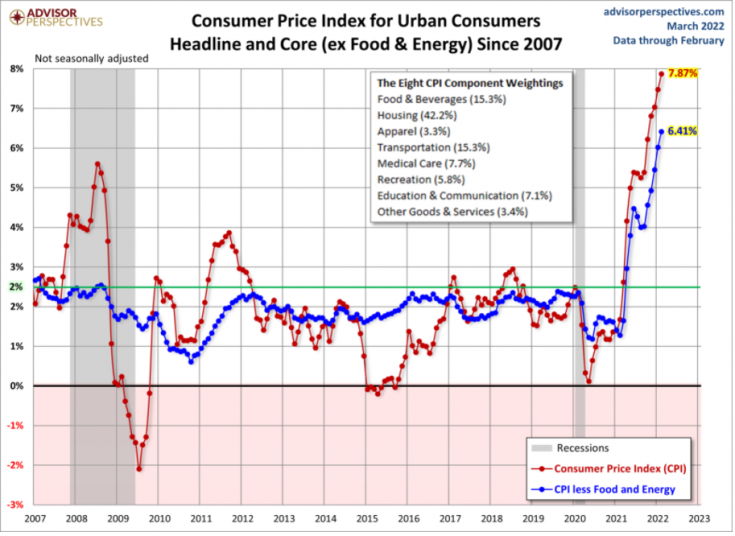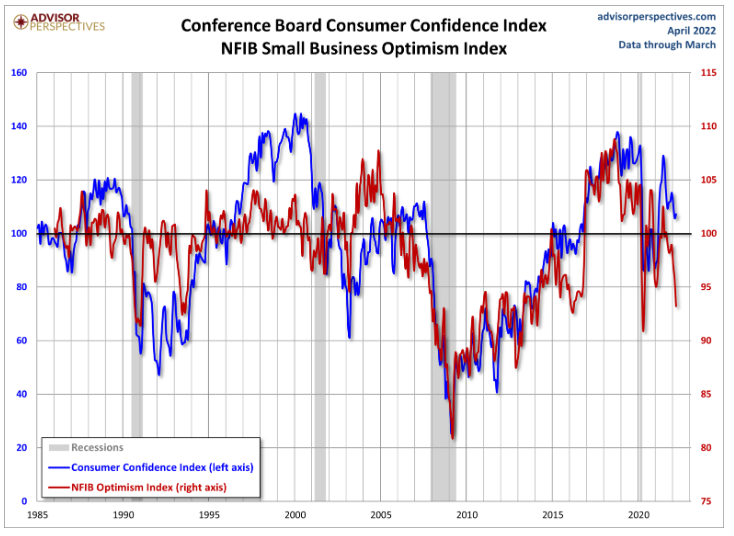Even giving my two cents worth each month is shrinking! Mike Tyson is famous for once saying, “Everyone has a plan until they get punched in the face.” I wonder what his seatmate’s plan was when he repeatedly insulted the former world boxing champion on a recent flight? My parents taught me that “sticks and stones may break my bones, but words can never hurt me.” In today’s rude and “cancel culture” it might be time to rethink that colloquialism!
Speaking of a punch in the face, we seem to be climbing a wall of worry. The S&P 500 is down more than 10% from its peak in January. Inflation is at a 40+ year high and ongoing supply chain issues are being extenuated by China’s COVID lockdown and the Russia/Ukraine war. Add rising interest rates and the U.S. political mess and you have to wonder how big a wall we can climb?
In general, inflation is kind to real estate. It can boost cash flow (raise rents) which leads to higher valuations. But that’s with 2% to 3% inflation. With 5% to 10% inflation, it starts eating into consumer spending forcing the Fed to pump the brakes. Consumers are already tapping the brakes themselves. Gas prices were up more than 18% in March, yet sales at gas stations grew by only 9%– telling me people are just not driving as much. In a recent survey, 53% of those surveyed said they had cut back on driving in the last six months. When tenants can’t pay higher rents and cap rates rise because of higher borrowing costs, it can be unkind to commercial real estate or an “RYFO” moment – (Rip Your Face Off)!
I was recently asked if a recession is a certainty, will it affect the booming housing market? My answer, “Yes, it is the only way people will know we are having a recession.”
The second question I am regularly asked is, “What about all of the office vacancy?” My answer remains the same, “It will fill back up.” Sam Zell recently said, “There is no substitute for motivation.” He also said, “I don’t know how you motivate by modem.” I can’t agree more, business leaders I speak with are concerned their culture is deteriorating. People need to be there to hear what they are saying about you. They need to be there to get the plum assignments.
Despite the rise of the metaverse and online working platforms, the vital role of the physical office as a place for collaboration and collective creativity will continue. But what will offices of the future look like? Many experts believe they will become social hubs, suggesting we could see the integration of bars, wellness spaces, expansive communal tables and residential-style lounges. Spaces will be adapted to enhance creativity, relationship building and face-to-face communication between professionals, while the hybrid working model will allow workers to use these new facilities in ways that best fit their own lifestyles and working needs. Cubicle farms are out. In 2022 and beyond, workspace providers will be delivering seamless video-conferencing suites to convivial social spaces, recording studios, hot desks that can be booked by app and al fresco forums for team gatherings.
For many companies, cutting-edge design will be used to boost motivation, creativity and a sense of ‘culture’. Even fun will have an important part to play – just think of tech giants such as Google, which, even pre-pandemic, had Lego zones, slides and bowling alleys built in. Access to green space will also become a major boon, suggesting that major companies could invest in surrounding parks and gardens for employees. Within the building, touchless technology powered by facial recognition, for example, could ease virus concerns. Workplace experience is clearly connected to other areas of focus, such as mental health and well-being, as well as employee retention and productivity. Companies such as Netflix and Jaguar Land Rover are powering the shift, leading the way by employing workplace experience managers to make their offices places where staff are happy to spend their days, and build a positive culture that manifests brand values. Although hybrid workers will only be going into an office or coworking space part-time, when they do, they will have a highly motivating experience. Workplace experience managers can also assist with events and extracurricular activities for teambuilding, which is essential to ensuring a sense of togetherness and inclusion.
Speaking of togetherness and inclusion, as we return to the office and work in these edgy belligerent times, how do we get along, so we don’t get punched in the nose? After all, we are supposed to be working together, not against each other. As we like to say here at CDC Commercial, “We’re here to do deals!”
We live in a world right now of noise and pressure and people feeling polarization everywhere they go. It would be nice for the world to stand still so everyone can catch their breath, but that’s not realistic. So instead, we need tools to work with one another harmoniously. Here are some that we use every day while “doing deals”.
- Start with empathy – find something to talk about that’s not the subject of your difficulty.
- Let them empty their cup first – when there is conflict, let the other person speak first. Find out why they believe so strongly in the other direction.
- Be curious – lead with a question (my favorites always start with “why”. Remember everyone is comfortable in their own realty.
- You may be closer than you think – find points of agreement.
- Choose acceptance – acceptance is understanding the situation for what it is, even if you don’t agree.
- Show respect – agree to disagree.
As much as I love our new digital world of Venmo, DocuSign and wiring funds, fraud is on a huge increase. Please be careful with your wire transactions:
- Call, don’t email (get numbers from original documents or business cards)
- Be suspicious – there shouldn’t be changes
- Confirm all #’s
- Verify when sent and/or received
Last year, Prop 19 went into effect. The impact of Prop 19 is just starting to be felt – another RYFO moment for many families. As most of you know, Prop 13 caps property taxes at 1% of the assessed value. So, property taxes typically didn’t increase much until a sale of the property. Prior to Prop 19, parents could transfer/bequeath property to their children, and the transferred property would retain its property tax basis despite the change of ownership. Now, either your heirs (under a gross lease) or tenants (under triple net leases) could see a big property tax increase. Time will tell, but the impact could make it difficult for heirs to retain property (there are some exclusions, but it affects residential property as well). For generations now, many homes were passed from homeowners to their children, providing them with homes in areas that would otherwise be impossible for them to move into, such as San Francisco or the beach communities of Southern California. You should definitely speak to your tax advisors, but there may be some workarounds available. A long-time friend, partner and attorney, Larry Murnane, provides this one as an example.
Nick’s Numbers
To illustrate Don’s point about inflation and the accompanying loss of confidence by consumers and small business owners, I have enclosed a couple of very illustrative charts. If you would like an evaluation of your property value, let me know.
Please give me a call or email me if you would like an analysis of your properties’ value or discuss what you should be doing with regards to interest rates or inflation and their impacts on your business, tenants, or property (Nick Zech, 858-232-2100, nzech@cdccommerical.com).
Since I got into the business, I have heard about 18-hour and 24-hour cities (think London, NYC, and San Francisco). Envious cities have tried to grow to this status. Frankly, it’s never been that attractive to me. However, my head was recently turned by an idea pioneered by French academic Carlos Moreno. It’s called the 15-minute city. The idea is for your work, live and play to all be within a 15-minute walk or easy bike ride. This could be one of the most dramatic and long-lasting legacies of the pandemic. I hope you enjoyed my two cents worth this month and the story…
Pennies from Heaven by Julie Bain
My dad loved pennies, especially those with the elegant stalk of wheat curving around each side of the ONE CENT on the back. Those were the pennies he grew up with in Iowa during the Depression, and Lord knows he didn’t have many.
When I was a kid, Dad and I would go for long walks together. He was an athletic six-foot-four, and I had to trot to keep up with him. Sometimes we’d spy coins along the way – a penny here, a dime there. Whenever I picked up a penny, he’d ask, “Is it a wheat?” It always thrilled him when we found one of those special coins produced between 1909 and 1958, the year of my birth. On one of these walks, he told me he often dreamed of finding coins. I was amazed. “I always have that dream, too!” I told him. It was our secret connection.
Dad died in 2002. By then, I was living in New York City which can be exciting, or cold and heartless. One gray winter day, not long after his death, I was walking down Fifth Avenue, feeling bereft, and I glanced up and found myself in front of the First Presbyterian Church, one of the oldest churches in Manhattan. When I was a child, Dad had been a Presbyterian deacon, but I hadn’t attended in a long time. I decided to go.
Sunday morning, I was greeted warmly and ushered to a seat in the soaring old sanctuary. I opened the program and saw that the first hymn was “A Mighty Fortress Is Our God,” Dad’s favorite, one we’d sung at his funeral. When the organ and choir began, I burst into tears.
After the service, I walked out the front doors, shook the pastor’s hand, stepped onto the sidewalk—and there was a penny. I stopped to pick it up, turned it over, and sure enough, it was a wheat 1944, a year my father was serving on a ship in the South Pacific.
That started it. Suddenly wheat pennies began turning up on the sidewalks of New York everywhere. I got most of the important years: his birth year, my mom’s birth year, the year his mother died, the year he graduated from college, the war years, the year he met my mom, the year they got married, the year my sister was born. But alas, no 1958 wheat penny—my year, the last year they were made.
Meanwhile I attended church pretty regularly, and along toward Christmas a year later, I decided I ought to join. The next Sunday, after the service. I was walking up Fifth Avenue and spotted a penny in the middle of an intersection. Oh, no way. I thought. It was a busy street; cabs were speeding by–should I risk it? I just had to get it.
A wheat! But the penny was worn, and I couldn’t read the date. When I got home, I took out my magnifying glass and tilted the copper surface to the light. There was my birth year.
As a journalist, I’m in a profession where skepticism is a necessary and honest virtue. But I found 21 wheat pennies on the streets of Manhattan in the year after my father died, and I don’t think that’s a coincidence.



